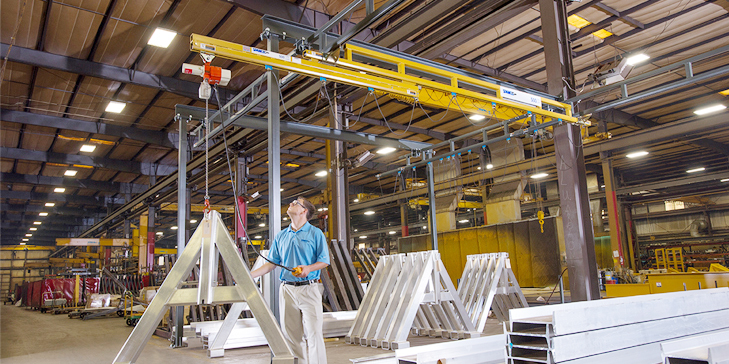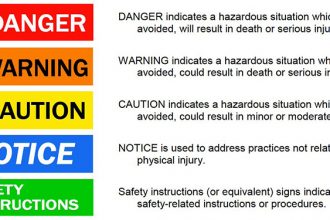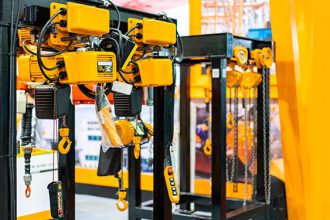Workstation Cranes And Monorails: How They Improve Worker Safety

Workstation bridge cranes and monorails are frequently deployed in manufacturing and assembly operations to assist workers who need to lift, handle, and move heavy objects as part of their assigned tasks. Both enhance worker safety in a variety of ways, making them an important technology for these operations.
Capable of handling loads from 250 to 4,000 pounds (with the majority of applications falling in the 1,000- to 4,000-pound range), workstation bridge cranes are dedicated to a specific location, area, or work cell. They are equipped with vertical lifting device (a hoist or other attachment) that suspends the load while the operator guides and positions it manually, or a powered trolley moves it mechanically. Typically capable of covering rectangular areas ranging in size from 10 x 10 feet to 34 x 400 feet, bridge cranes are mounted overhead to a building’s ceiling or floor (on free-standing columns). They are equipped with a vertical lifting device (typically a hoist) suspended to a trolley. The trolley is connected to a bridge beam for side-to-side movement, while the bridge beam rides along a runway for lateral movement.
Workstation bridge cranes improve worker safety by enhancing ergonomics. Because the load is suspended by the workstation crane’s hoist, the operator no longer has to bend down or lift the load. Instead, the crane and hoist eliminate the physical exertion, as well as strains and the risk of potential injury from repeatedly picking up a heavy item manually.
Additionally, the effort required to push and pull heavy loads is significantly reduced. With a workstation bridge crane, the bridge rolls effortlessly (with push force less than 1/100th of the weight carried) along the runway, while the trolley does the same on the bridge. The system features wheels and bearings that ensure the smooth and easy — yet controlled — movement of the hoist and load. Some workstation bridge cranes feature powered travel on both bridge and trolley; others just a powered trolley. Whether the components are powered or not, the systems are engineered so that the load travels easily, with minimal effort on behalf of the worker. The systems are also highly responsive for finer control and more accurate positioning of the load when compared to a much larger overhead electric crane.
Further, workstation bridge cranes can be equipped with a telescope option. This attachment connects to the bridge and temporarily extends the hoist’s reach. Typically positioned to stretch into an adjacent aisleway, a telescopic beam allows the trolley to travel beyond the boundaries of the rectangularly constructed workstation crane so the hoist can connect to a load deposited in the aisle, or to place a load outside the work cell. These attachments enhance worker safety by enabling the operator to retrieve or place a load without physically handling it. They also eliminate the potential for a worker to attempt a dangerous side-pull — or pulling the hoist and its chain or wire at an angle and out of plumb from under the trolley to reach a load — a maneuver that is unsafe and should never be permitted.
As for monorails — which move loads overhead (horizontally, vertically, and laterally) on trolleys or carriers suspended from a continuous run of fixed, overhead tracks — they improve worker safety by moving loads far above floor level. They can significantly minimize forklift traffic, which minimizes the risk of a worker being struck by such a vehicle. Monorails also free up floorspace, which reduces trip hazards associated with pallets or skids of materials stored on the facility floor. Finally, monorails eliminate manual loading and unloading of parts on skids, as they can be designed to pick up and deposit loads at a specific point with minimal effort required of workers.
Want to learn more ways workstation bridge cranes and monorails can help your workers be both safer and more productive? The members of the Monorail Manufacturers Association (MMA) are the industry’s leading suppliers of workstation crane systems. The group offers a variety of resources—including a product certification program, recommended practices for workstation cranes and patented track systems, and more—via its website at www.MHI.org/MMA.



